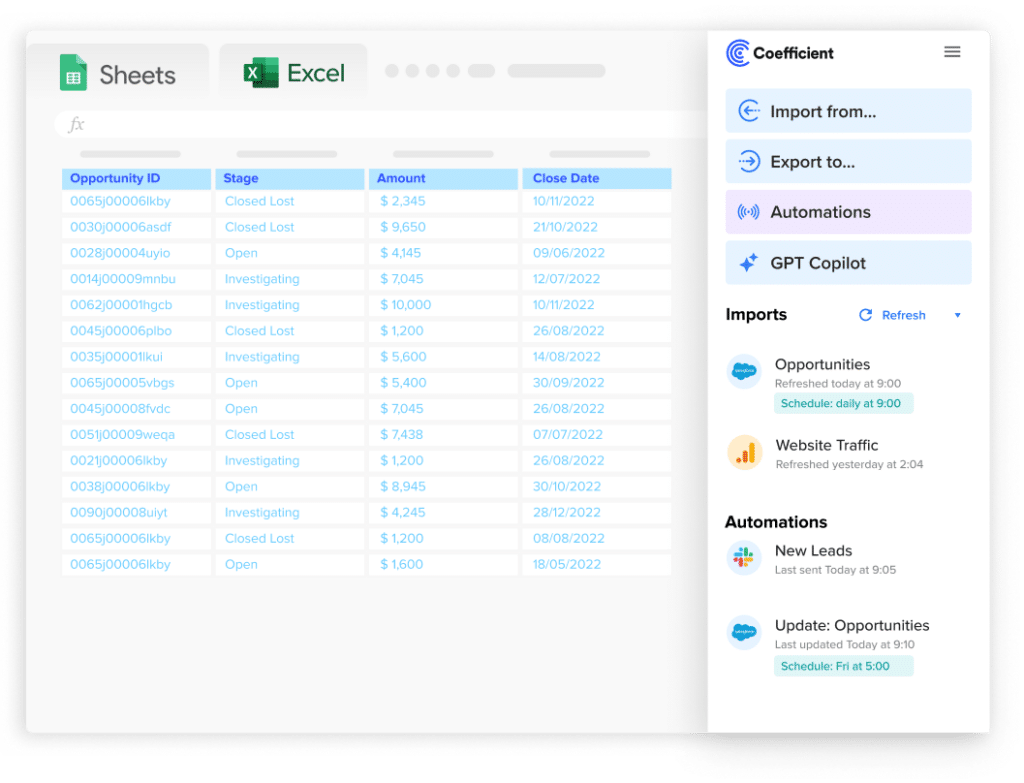Excel is one of the most powerful tools for managing and analyzing data, and yet there are so many people who hate it or don’t know how to use it right. In fact, only 0.1% of all people know how to use it to its full potential, of which we can judge by numerous Google searches.
If you are one of these people but you’re looking to harness the power of this tool, here’s some good news – the integration of AI not only makes the use of Excel easier but also helps save lots of time by automating tedious cleaning tasks, making it a much more efficient and user-friendly for everyone.
Now instead of spending hours sorting missing values, removing duplicates, and figuring out what goes where, you can clean and organize data in Excel with minimal effort, in a fraction of the time.
In this article, we’ll dive into the AI techniques and tools used for data cleaning in Excel that will help you cut the time required for data management at least by half. Let’s get the ball rolling!
Data Cleaning in Excel: What Is It?
If you’ve got experience working with Excel sheets, you know firsthand how tedious data-cleaning tasks can be. Oftentimes, before the file can be used, it needs heavy reformatting.
Say you’ve got a file with thousands of rows containing both numeric values and comments. If you had to sift through this data manually to bring it to one format, correct spelling mistakes, or remove irrelevant or duplicate cells, you’d have to spend a good part of the day.
This process of standardizing formats and cleaning inconsistencies, whether in values or numbers, is what’s known as “data cleaning” – an essential first step in preparing data for further analysis. As a result of the cleaning, you should get a well-structured dataset.
Embedded AI Tools
Luckily, the integration of AI has freed us from the burden of sorting Excel data manually. Now instead of cleaning data manually, you can use embedded AI tools that can pull miracles and do all the hard work for you. Let’s take a look at some of the most useful tools you should be using for data-cleaning tasks if you haven’t done so already.
Power Query
Without a doubt, Power Query stands to its name. It’s one of the best tools built into Excel to streamline data cleaning. With the help of this tool, you can connect, transform, and clean data from various sources without spending nearly as much time as you would do if you did it manually. It is also a great tool for finding and removing duplicates and standardizing mismatched data for hassle-free calculations.
The best thing about Power Query is that it can work both with datasets stored on your computer drive and those stored in the cloud, making it an extremely versatile data processing tool. Another advantage of Power Query is its ability to save transformations as reusable steps, which may come in particularly handy for recurring tasks. Add to this the user-friendly interface of the tool and you can guess why it’s been so popular among Excel users.
The many functionalities of Power Query render it particularly useful for tasks with regularly updated data, such as monthly sales reports or weekly project tracking sheets. By using saved queries, you ensure that the data you work with is cleaned and standardized, minimizing potential errors and reducing manual effort on your side.
Power Query is a powerful tool built into Excel that allows users to connect, transform, and clean data from various sources with minimal manual effort. It uses AI-driven functionalities to perform tasks like filtering, splitting columns, merging data, and handling missing values.
Power Query’s ability to save transformations as reusable steps makes it especially valuable for recurring data-cleaning tasks. You can import data from multiple sources, apply consistent cleaning steps, and refresh the dataset with updated data instantly.
DataRobot
Another popular AI tool used in Excel is DataRobot. The strength of this tool is that it can automatically detect and flag unusual records in your data, making it ideal for identifying outliers and anomalies that may skew your analysis.
Here’s how DataRobot works. Its algorithms analyze patterns and learn what’s considered “normal” values, helping it spot irregular entries. This capability makes it particularly valuable for processing spreadsheets with thousands of records, such as sales datasets, where manual cleaning would be hardly possible.
With the help of DataRobot, you can check if there are any errors or inconsistencies in a doc early, saving the headaches of doing major reworks later on when the incorrect data is already being used affecting your analysis and decisions.
While using tools like Power Query and DataRobot for data cleaning in Excel, a password manager can help maintain security by safeguarding access to important files and credentials, ensuring efficient workflows without risking data breaches.
Once you know what’s wrong, you can decide what to do next – correct the mistake, investigate further, or remove the anomaly entirely.
Another great capability of DataRobot is missing value filling, which can be useful when dealing with reports. The tool can predict what values have been dropped based on patterns in the processed data.

Stop exporting data manually. Sync data from your business systems into Google Sheets or Excel with Coefficient and set it on a refresh schedule.
Get Started
FlashFill
If you often work with reports where you have to separate names or reformat phone numbers to match one style, you definitely should give FlashFill a go. This is one of the best AI tools for these kinds of tasks that can quickly reformat thousands of data based on a few examples you provide.
This tool can be used in two ways: manual and automated. For example, you can enter an example of the data format you need in a cell and, after you press the combination Ctrl+E, the tool will fill in the rest values. Another way to do this is by providing a few examples in adjacent cells. Based on your examples, FlashFill will come up with suggestions for the rest of the values.
For organizations dealing with complex datasets, investing in custom software development can provide tailored AI solutions to address specific data-cleaning challenges, ensuring greater efficiency and accuracy in Excel workflows.
AI Techniques Used for Excel Data Cleaning
AI cleaning in Excel has become possible thanks to a number of sophisticated techniques. These include machine learning (ML), natural language processing, and even AI custom models built based on specific user needs. Let’s break down these approaches.
Machine Learning
Machine learning excels at recognizing similar specifications and patterns. It’s thanks to ML algorithms that we can automatically identify and group similar data without manually sifting through each entry. With their ability to learn from past data, ML algorithms can quickly spot anomalies that shouldn’t be in the datasets and get rid of them, clustering the data into clean, consistent, and standardized groups.
NLP
NLP, in turn, proves indispensable in tasks requiring filtering text data, which Excel users come across every day. Using NLP, AI tools can easily filter and process unstructured data, extracting names, locations, and dates from text fields. Furthermore, because NLP can understand language, it is helpful for analyzing data based on sentiment, allowing users to quickly sort large volumes of feedback, surveys, and other qualitative information.
Using advanced features like NLP, tools for email search can effectively extract and organize contact details from unstructured datasets, saving time and improving the accuracy of communication efforts in data-intensive projects.
Custom Models
Besides these two, AI platforms can be trained to meet the unique needs of organizations. For example, if a business works with industry-specific data that doesn’t follow standard patterns, they may need their own validation rules to perform cleaning tasks. In cases like this, using just built-in AI tools might not be enough, and it would be necessary to engage developers to incorporate custom functionality.
Advantages of AI-Driven Data Cleaning in Excel
While the advantages of AI are pretty clear for users who may feel unconfident with Excel, even more advanced can greatly benefit from the automation of data cleaning automation, and here’s why:
- Time-saving. AI-powered tools automate repetitive tasks, saving users significant time and effort they would spend completing these tasks manually.
- Improved accuracy. Errors in reports are something that is difficult to prevent if the report is compiled by a person, but with AI, inconsistencies are detected spot-on, making it particularly valuable for large datasets.
- Scalability. Whether you’re working with a few hundred or several thousand rows, AI can easily clean the data without slowing down the process.
- Consistency. For companies working with data coming from different sources, AI tools ensure that this data is structured into a consistent format, making analysis and reporting easy.
- Data Enrichment. AI tools are helpful not only for removing and fixing errors but also for adding information to your datasets. Thanks to ML, they can scour external sources and fill in missing data to make your reports more valuable and complete.
- Cost-effective. By utilizing AI tools, you can save money that would otherwise be spent on hiring expensive data scientists or investing in specialized software.
- Continuous improvement. Last but not least, AI tools continually improve. As you use them more, they will better understand what you want from them, helping them adjust their algorithms to meet your unique needs.
Conclusion
To cut to the chase, AI is making Excel easier than ever, especially for data cleaning – a task that usually takes hours to complete, even if done by a seasoned data analyst. With AI, now, anyone regardless of their experience with Excel can perform complex data-cleaning tasks and do it quickly and accurately without much of an effort.
Whether you need to sort your accounting reports or gather insights from customer feedback, AI makes these tedious tasks an easy job. Even people who’ve avoided Excel in the past might start using it more, thanks to how AI takes the hard work out of data handling.

